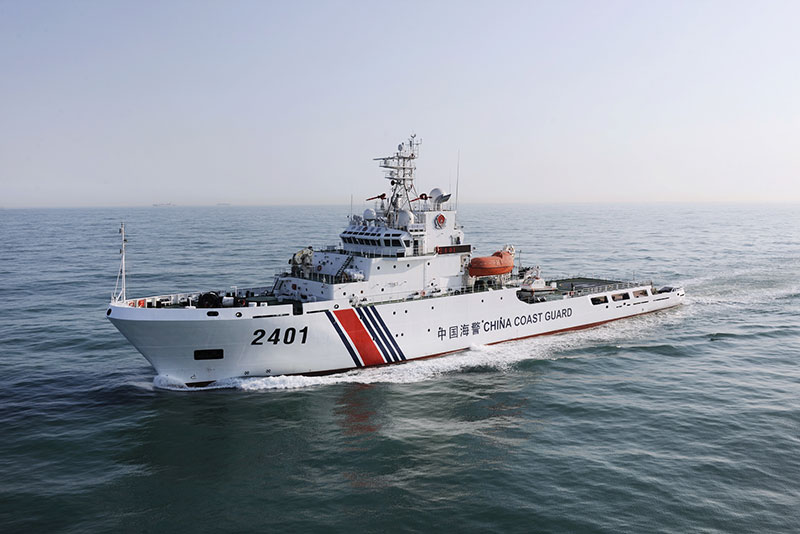In recent years, the US has highlighted that China has three maritime forces, namely the navy, the Coast Guard, and “maritime militia”. In April 2019, John Richardson, former Chief of Naval Operations for the US Navy, said that Washington would not treat the coast guard or maritime militia differently from the Chinese Navy. Noncompliance with relevant rules will prompt a military response from the US. In the strategic dialogues between the two countries and two militaries, the US has repeatedly emphasized the necessity of expanding the rules of air and maritime encounters to coast guard and “maritime militia”, such as the Code for Unplanned Encounters at Sea (CUES), and including the coast guard in bilateral dialogue mechanisms, such as the China-US Military Maritime Consultative Agreement (MMCA). During other bilateral official, semi-official exchanges and think-tank communications, the US insists on taking the issue as the top priority of crises management and frequently accuses China of its negative attitude toward the issue and insincerity in crisis management. Nevertheless, in my point of view, such requirements of the US are not only unrealistic but also unreasonable; it is just within the expectations that no response has been made on the Chinese side.
First of all, it is very rare for any ship or aircraft of the US military to dangerously encounter the Chinese Coast Guard (CCG) and the so-called “maritime militia”. Where any activities of the US warships or military aircraft are identified in waters surrounding China, the People’s Liberation Army (PLA) would dispatch naval and air forces for tracking and surveillance according to international practices. However, these actions generally have no relation with the coast guard or other civilian forces. As China introduces and promotes military reform, its strategic thinking is also changing, with more focus being placed on military professionalism. Moreover, the naval and air forces of the PLA have grown powerful in dealing with the ships and aircraft of the US military, fully capable of safeguarding China’s sovereignty and security. In this sense, there is no need for China to engage its coast guard and even fishing vessels. In reality, even the US itself admits that, at least in the recent decade, the ships and aircraft of the US military cannot raise any example of dangerous encounters with the CCG or “maritime militia” it refers to. Indeed, it is quite normal for the US warships at sea to encounter government vessels and civilian vessels of Chinese nationality; yet all of these daily encounters are bound by international rules. For example, since being enacted on July 15, 1977 under the leadership of the International Maritime Organization (IMO), the Convention on the International Regulations for Preventing Collisions at Sea, 1972 has become the “rules of the road” at sea that are globally recognized. Both China and the US are members of the Convention.
Secondly, law enforcement forces like the coast guard differ from a pure military force in terms of functions, responsibilities and nature of operations. The CCG and the United States Coast Guard (USCG), both paramilitary actors, are characterized by their dual power in military operations and law enforcement, and the US even specified the military attribute of USCG in the United States Code. In several recent deployments in the Western Pacific, the ships of USCG especially highlighted their attribute as “warships”. As long as the USCG, as an armed force, operates in the waters surrounding China without encroaching on China’s sovereignty and security, it is very likely that China handles relevant issues in a restrained manner. However, though a law enforcement force, the USCG itself has no law enforcement power in the disputed waters involving China and can only accept rights alienated by other countries, which pushes the US to the frontline and makes it a focus of disputes.
It is noteworthy that, as provided in the United States Code, “waters over which the United States has jurisdiction” can be exclusive economic zones (EEZs) of the US, or waters over which the US gains jurisdiction as a result of the other countries’ alienation of right to EEZs. No matter under what excuses or having what agreements with other claimants, the law enforcement activities of the USCG in China’s surrounding waters, especially the disputed waters, are blunt provocations that is more serious than ordinary activities of warships, and can thus be viewed as deliberate incitement. Under these circumstances, the primary duty of the CCG is to protect national rights rather than complying with the safety rules governing daily encounters—which is actually a universally acknowledged practice worldwide. The coast guard is, after all, unlike a pure military force. In the process of law enforcement and right protection, the coast guard has certain enforceable and confrontational characteristics by nature, which may even exceed military forces in peacetime. With domestic laws and relevant maritime claims as the major basis, law enforcement and right protection activities of the coast guard are in nature conducts of the police. In this sense, the rules of encounters for naval ships or naval aircraft are inapplicable.

China Coast Guard
In addition, since the capabilities and spheres of activities of the Chinese and US coast guards are not equal—the USCG deploys its power globally whereas the CCG mainly operates in waters surrounding China, expanding CUES and other rules to cover coast guards is unfair to China. As China views it, the proposal is actually designed to facilitate the US military’s intervention in the maritime disputes involving China. Lastly, within the framework of such multilateral mechanisms as CUES, it is inappropriate for both China and the US to go their own way.
Lastly, within the framework of such multilateral mechanism as CUES, it is inappropriate for only China and the US to go their own ways. According to the CUES adopted in 2014, necessary safety measures and means should be taken to limit mutual interference, to limit uncertainty, and to facilitate communication when naval ships or naval aircraft encounter each other in an unplanned manner. CUES sets out standards for the legal status, rights and obligations of naval ships and naval aircraft, and offers safety procedures, communication procedures, signal vocabulary and basic maneuvering instructions for their unplanned encounters at sea. The jurisdiction is also clearly stated, i.e., the military forces of contracting parties. When it comes to the application of CUES on the coast guard and other forces, it would be best for the contracting parties to engage in further negotiations. Expanding the scope of application by China and the US is against the balance of rules.
Though navies have well-defined functions and traditions of exchange and cooperation, maritime law enforcement agencies vary greatly in terms of the responsibilities, professionalism as well as modes of management. Therefore, implementing such a proposal is fraught with technical difficulties. Especially, the weaker a country is, the less willingly it would be to clip its wings in maritime rights enforcement, hence harder to implement rules of encounters such as CUES.

